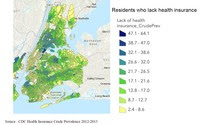Follow Key Tips to Protect your Child’s Personal Information, Stay Safe in a Dorm & Back to School Shopping
The New York State Division of Consumer Protection is today providing consumers with basic tips for students of all ages as classes are once again back in session. Consumers are urged to be mindful of their privacy, their dormitories, and back to school spending to protect themselves.
“Heading back to school is often an exciting time for families, and it’s also an opportunity to start new routines,” said Secretary of State Rossana Rosado. “As part of your new back-to-school routine, I encourage all New Yorkers to consider some basic tips to help keep students from elementary school to college safe this school year.”
Identity Theft
From 2019 to 2020, reports of identity theft increased by 85% in New York State, according to Federal Trade Commission (FTC) Consumer Sentinel Network data books 2010-2020.
The Division of Consumer Protection suggests these identity theft precautions when headed back to school:
- Only label books, backpacks and lunches with your full name and any other information on the inside! Using initials on the outside is okay, but names, even just first names, on the outside can create an unsafe situation.
- Be careful when providing identifying information to after-school activities and sports clubs upon registration. If asked for a Social Security number, inquire why it is needed and insist on using another identifier.
- Register your cell phone with the National Do Not Call Registry so you are not solicited by savvy telemarketers who may encourage you to give out personal information.
- Regularly check online social networks. For children, discuss internet safety. Be aware that any information you post on Facebook or other social networks can be seen and utilized by identity thieves. Caution children never to reveal personal information including full names, addresses, phone numbers, Social Security numbers, or even where they go to school. This information may be used by online predators looking to exploit them or reveal answers to security questions used to reset passwords, making your child a possible target of scammers looking to access accounts or secure information.
- Turn on two-factor authentication. Two-factor authentication will require your password and an extra security code to verify your identity whenever you sign into your accounts.
College Dormitory Safety
For those living on campus this fall, there are safety precautions to keep in mind, especially for first-time residential students. Fires are one of the biggest hazards; the National Fire Protection Association reports that fire departments responded to over 3,000 fires at dormitories, sororities, fraternities, and other related structures from 2015-2019. Be sure to check your dormitory for fire hazards and more, and have the following information handy:
- Locate the smoke and carbon monoxide alarms within your dorm or off-campus housing. Verify or obtain assurances that all alarms are in proper working order. Participate in any needed safety demonstrations on campus.
- Check for working sprinkler systems and fire extinguishers. Most at risk are those staying in off-campus housing, where these systems are not regulated by the university.
- Locate the nearest emergency exits. Make note of where to go if there is an emergency.
- Never overload outlets with too many demands for power to prevent fires. Students with laptops, televisions, mini-refrigerators, and more can overload the power and spark a fire.
- Review the emergency plan in case of fire or a carbon monoxide leaks. Ensure all those residing in the room know where to meet and what to do if there is an emergency. Remember to call 911 in case of any emergency and follow safety protocol.
Back-to-School Shopping
Last-minute shopping for school can be frantic and disorganized. The Division of Consumer Protection urges consumers to take note of common mistakes while navigating the marketplace:
- Use caution when using credit cards:Back-to-school purchases may cost more than what is on your receipt. Track your spending, be cognizant of credit card limits, and stick to a realistic budget. Consumers should verify receipts and reconcile them against their statement. Consumers should also always review monthly credit card statements carefully to ensure they are being billed for the correct dollar amount.
- Beware when purchasing “Big Ticket” items:When purchasing big ticket items like computers or tablets, look for and review warranty coverage on the specific item. Review the financing options carefully and ensure you understand the terms and rates. Always take note of the fine print and the quantity of the product available at the advertised price, as well as whether rain checks are available.
- Review refund and return policies:Review a store’s refund policy before considering a purchase. If the store does not post a return policy, the law requires the store to accept a return within 30 days of purchase, with proof of purchase. Retain receipts in the event items need to be returned. Shoppers should inquire whether the store imposes a re-stocking fee for returned merchandise and determine prior to purchase if the item can be returned for a refund or store credit only.
- Protect your identity when shopping online:Protect personal, identifiable information when making purchases online. It is imperative that consumers ensure they are conducting their transactions over a secure connection. See more information in this August 2020 Consumer Alert.
- Beware of fake websites: As fraudsters continue to advance in sophistication, fake websites frequently resemble legitimate sites with credible-looking logos, pictures, and payment options. If the website is advertising extremely low prices, or discounts beyond 50 percent, consumers should be wary and diligently verify the legitimacy of the seller.
About the New York State Division of Consumer Protection
The New York State Division of Consumer Protection serves to educate, assist, and empower the State’s consumers. Consumers can file a complaint with the Division of Consumer Protection at https://dos.ny.gov/
For more consumer protection information, call the DCP Helpline at 800-697-1220, Monday through Friday, 8:30am-4:30pm or visit the DCP website at https://dos.ny.gov/consumer-




